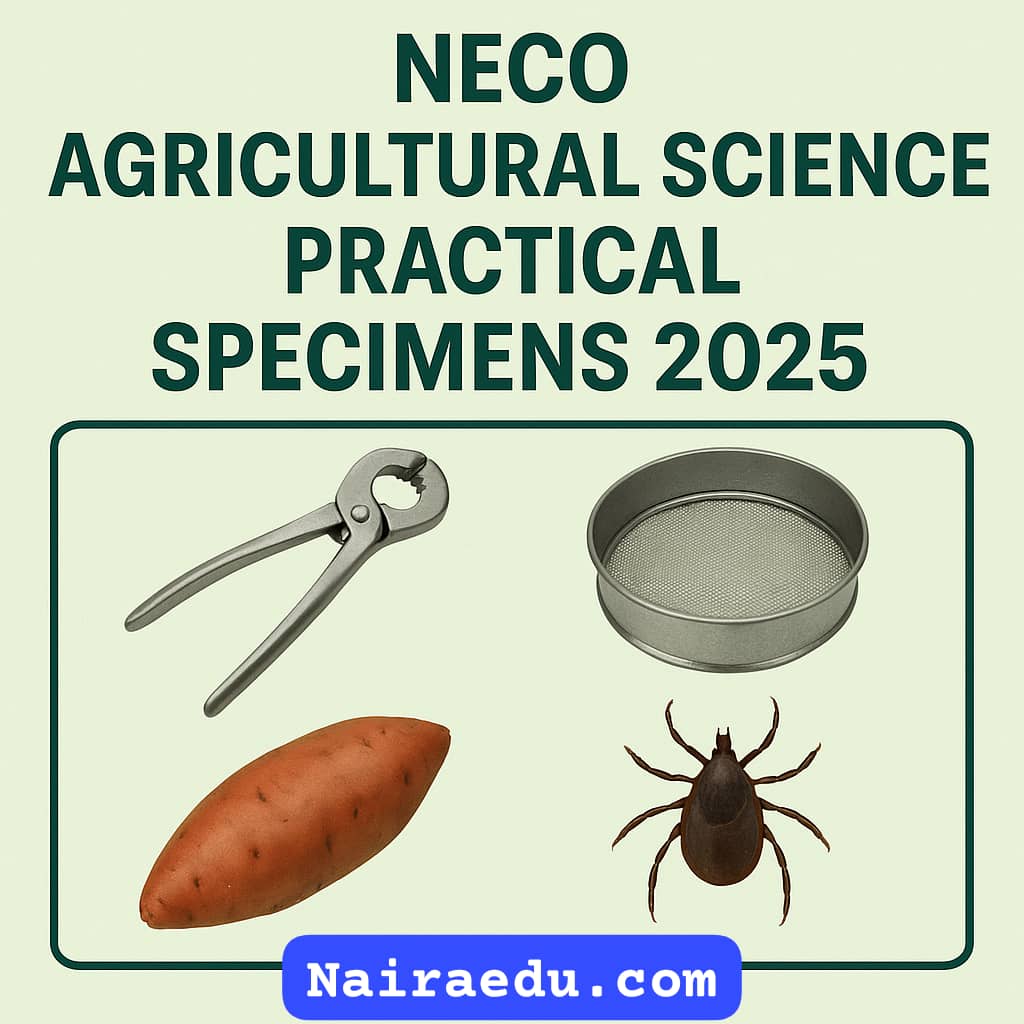As we all know, NECO Agricultural Science Practical is a very important part of the NECO exam. It is not just about reading books, it is about identifying real farming tools, materials, and even some common farm pests and crops. For the 2025 NECO Agric Practical, students will be asked to observe and answer questions based on real life specimens.
This year specimen list has been released, and it includes tools like the Burdizzo, farm inputs like Calcium Carbonate, and even crops like Sweet Potato. As a teacher, I advise all students to take this part seriously, because it carries a lot of marks.
In this post, I will show you the full list of NECO Agricultural Science Practical Specimens for 2025, explain each one in simple terms, and also give you some likely exam questions that may come from them.
Full List of NECO Agricultural Science Practical Specimens 2025
Below is the complete and official list of the NECO Agricultural Science Practical Specimens for the 2025 exam. Each specimen is labeled with a letter (A to K), and students will be expected to identify, describe, or state the use of some of them during the practical exam.
Please take note of the spelling and names of the tools and materials. Some may be familiar, while others may be new to you.
| Specimen | Name |
|---|---|
| A | Burdizzo |
| B | File |
| C | Manure Drag |
| D | Granite |
| E | Calcium Carbonate |
| F | Sieve |
| G | Kolanut |
| H | Sweet Potato |
| I | Tick |
| J | Louse |
| K | Meat (Fresh) |
Tip for students: Try and get a look at these specimens in real life, either from your school lab, the farm, or pictures online. The more familiar you are, the better your answers will be.

Explanation and Uses of Each Specimen
Specimen A – Burdizzo
Burdizzo is a special tool used to castrate male animals like bulls and goats without causing bleeding. It works by crushing the sperm cords inside the scrotum, which makes the animal unable to reproduce. Farmers use it to control breeding and reduce aggressive behavior in male animals.
Specimen B – File
A file is a simple tool used to smooth rough edges of metal or sharpen farm tools like cutlasses and hoes. It is mostly made of strong metal and has a rough surface. In the farm workshop, files help maintain tools in good working condition.
Specimen C – Manure Drag
A manure drag is used for spreading manure across the farm or collecting animal waste from the pen or shed. It helps to keep the animal house clean and also allows the farmer to recycle animal waste as fertilizer on the farm.
Specimen D – Granite
Granite is a type of hard rock. In agriculture, it can be crushed and used to build farm structures or provide drainage. Sometimes, it is also mixed with concrete to build fish ponds, barns, or farm roads.
Specimen E – Calcium Carbonate
Calcium Carbonate is a white powder used to reduce soil acidity (increase pH). It is a type of liming material that helps improve soil quality and boosts crop production. Farmers apply it to acidic soils to allow plants to absorb nutrients better.
Specimen F – Sieve
A sieve is used for separating particles of different sizes. In farming, it can be used to clean seeds by removing sand or stones or even to separate manure from bedding materials. It has a wire mesh and a wooden or metal frame.
Specimen G – Kolanut
Kolanut is a fruit commonly grown in Nigeria. It has cultural and economic importance, especially in the South. In agriculture, kolanut is studied as a cash crop. It grows on a tree and is rich in caffeine. It is also used in traditional ceremonies and sold for income.
Specimen H – Sweet Potato
Sweet potato is a root crop grown for food. It is rich in carbohydrates and can be boiled, roasted, or fried. The plant also has vines and can be grown by planting the cut vines directly into the soil. It is important in both subsistence and commercial farming.
Specimen I – Tick
A tick is a blood-sucking parasite that attaches itself to livestock like cattle and goats. It can cause diseases like babesiosis and anaplasmosis. Farmers control ticks using chemicals called acaricides. Ticks reduce animal productivity and must be controlled properly.
Specimen J – Louse
A louse (plural: lice) is a tiny insect parasite that lives on the body of animals and feeds on their blood or skin. It causes irritation, itching, and may lead to wounds. Just like ticks, lice affect the health and growth of farm animals, especially poultry and goats.
Specimen K – Meat (Fresh)
Fresh meat is animal flesh that is ready for consumption. It is rich in protein and is a major part of human diets. Agric students should learn how to identify quality meat, detect spoilage, and understand how it is stored and processed from farm to market.
Advice: All these specimens are important and can appear in both identification and explanation type questions. Don’t just cram, understand them and practice how to describe each one clearly.
Likely NECO Agricultural Science Practical Questions 2025
Here are some possible questions that NECO may ask during the 2025 Agricultural Science Practical exam. Students are expected to give clear and short answers based on observation and understanding.
Number 1. Specimen A
- Identify Specimen A.
- State one use of the specimen.
- Mention one precaution to take when using it.
Number 2. Specimen E
- What is Specimen E?
- State its function in crop production.
- Name one crop that benefits from its application.
Number 3. Specimen I and J
- Identify Specimen I and Specimen J.
- Mention one difference between them.
- State one effect of each on farm animals.
Number 4. Specimen G and H
- Identify specimen G & H.
- Which one is a root crop?
- Mention one economic importance of each.
Number 5. Specimen A (Burdizzo) and B (File)
- Which one is used in animal management?
- Which one is used in tool maintenance?
- Mention one reason why both are important on a farm.
Number 6. Specimen K
- Identify the specimen.
- List two qualities of fresh meat.
- What is one sign that meat has gone bad?
Number 7. Specimen F
- Name the specimen.
- What is its use in crop or seed processing?
- Mention one material that can be separated using this tool.
Tip: During the exam, write your answers in clear and simple English. Don’t use big grammar; just go straight to the point. For example: “Specimen A is a Burdizzo. It is used to castrate male animals.”
RELATED POST:
NECO Data Processing Practical Questions And Answers 2025
NECO Chemistry Practical Questions And Answers 2025
2025 NECO Biology Questions And Answers
NECO 2025 Timetable Is Out – See Full Schedule (Download PDF)
Conclusion
The NECO Agricultural Science Practical exam is not something to fear if you prepare well. As we have discussed, you already have the full list of specimens for 2025, along with their meanings, uses, and possible exam questions. All you need now is consistent revision and confidence.
Make sure you understand each specimen and can describe it in simple English. Practice how to identify tools, pests, crops, and materials. If you follow the tips in this article, success is very possible.
Remember, practical exams test what you can observe and explain, not just what you cram. So be focused, stay calm, and attend all your Agric classes and revisions.
If you found this post helpful, please share it with your classmates or school WhatsApp group. You can also leave a comment below or bookmark this page for later.

Mr. Femi is an education blogger who simplifies exam updates and study tips for Nigerian students. His goal is to make learning smart, easy, and rewarding.


2 thoughts on “NECO Agricultural Science Practical Specimens 2025”